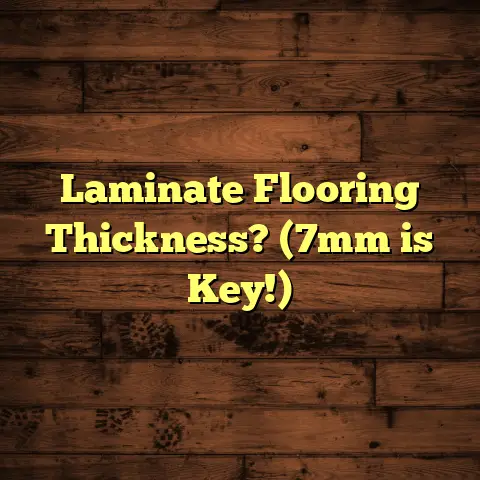What’s In Engineered Flooring? (9 Layers Exposed!)
Have you ever walked across a beautiful floor and wondered, “What’s really going on under there?”
Well, if it’s engineered flooring, there’s a lot more than meets the eye!
I’m going to take you on a journey through the nine layers that make up this popular flooring choice.
We’ll explore what each layer does, why it’s important, and how it all comes together to create a floor that’s both stunning and durable.
Whether you’re a homeowner, a builder, or just curious, understanding the structure of engineered flooring is key to making informed decisions.
So, let’s peel back the layers, shall we?
1. Introduction to Engineered Flooring
Okay, first things first: what is engineered flooring?
Simply put, it’s a type of flooring made from multiple layers of wood or wood-based materials that are pressed together.
Unlike solid hardwood, which is one solid piece of wood, engineered flooring is designed to be more stable and less susceptible to moisture and temperature changes.
Why is understanding its structure so important?
Well, for homeowners, it’s about knowing what you’re investing in.
You want a floor that looks great, lasts long, and performs well in your specific environment.
For builders, it’s about choosing the right materials for the job and ensuring a successful installation.
And for everyone, it’s about appreciating the craftsmanship and engineering that goes into creating a beautiful and functional floor.
Now, let’s get into the nitty-gritty and explore each of those nine layers!
2. Layer 1: The Top Wear Layer
This is the layer that takes all the beating!
The wear layer is the topmost surface of your engineered floor, and its primary job is to protect the underlying layers from scratches, stains, and everyday wear and tear.
What’s it made of?
Well, that depends on the type of engineered flooring.
Some have a thin layer of real hardwood veneer, while others use a clear coating like aluminum oxide or polyurethane.
Aluminum oxide is particularly tough and is often used in high-traffic areas because of its superior scratch resistance.
How thick is it?
Wear layer thickness can vary quite a bit, typically ranging from 2 mil (thousandths of an inch) to 6 mil or even thicker.
A thicker wear layer generally means better durability and a longer lifespan for your floor.
Think about it this way: the thicker the wear layer, the more material there is to wear away before the underlying decorative layer is exposed.
So, if you have kids, pets, or a busy household, opting for a thicker wear layer is definitely a smart move.
3. Layer 2: The Decorative Layer
Ah, the pretty part! The decorative layer is what gives engineered flooring its distinct look and style.
This layer sits directly beneath the wear layer and is responsible for the floor’s color, pattern, and overall aesthetic.
For engineered wood flooring with a real wood veneer, this layer is simply a thin slice of the desired wood species, such as oak, maple, hickory, or walnut.
The veneer is carefully selected and applied to showcase the natural grain and beauty of the wood.
For other types of engineered flooring, the decorative layer may be a printed design or a photographic image that mimics the look of real wood, stone, or tile.
The quality of the printing technology used here is crucial.
High-quality printing can create incredibly realistic and detailed designs that are difficult to distinguish from the real thing.
This opens up a world of possibilities in terms of style choices.
You can achieve the look of exotic hardwoods without the hefty price tag or the environmental concerns associated with harvesting rare species.
4. Layer 3: The Core Layer
Now we’re getting into the structural heart of engineered flooring: the core layer.
This layer provides stability, strength, and moisture resistance, all of which are essential for a long-lasting floor.
The core layer is typically made of plywood, high-density fiberboard (HDF), or medium-density fiberboard (MDF).
-
Plywood: This is a common choice for its excellent stability
and resistance to warping. It’s made by gluing together multiple
layers of wood veneer, with the grain running in different directions
for added strength. -
HDF: HDF is a denser and more rigid material than MDF,
making it a good choice for areas with high traffic or heavy furniture.
It’s made from wood fibers that are compressed under high pressure
and heat. -
MDF: MDF is less expensive than HDF and plywood,
but it’s also less resistant to moisture.
It’s best suited for areas with low humidity and minimal risk of spills.
The core layer plays a critical role in preventing the flooring from expanding, contracting, or warping due to changes in temperature and humidity.
A well-constructed core layer will help your floor maintain its shape and appearance for years to come.
5. Layer 4: The Backing Layer
The backing layer is the bottom-most layer of engineered flooring, and it serves several important functions.
It provides a stable base for the flooring, helps to dampen sound, and adds comfort underfoot.
The backing layer is typically made of cork, foam, or another resilient material.
-
Cork: Cork is a natural and sustainable material
that offers excellent sound insulation and cushioning. -
Foam: Foam is a lightweight and affordable option that also
provides good sound absorption and comfort.
The backing layer can have a significant impact on the overall performance and longevity of your floor.
A good backing layer will help to reduce noise transmission between floors, making your home quieter and more peaceful.
It will also make the floor feel softer and more comfortable to walk on, which can be especially important in areas where you spend a lot of time standing, such as the kitchen.
6. Layer 5: The Adhesive Layer
This is the unsung hero of engineered flooring!
The adhesive layer is the glue that holds all the other layers together.
It’s a critical component of the flooring’s structural integrity, and a strong, reliable adhesive is essential for preventing delamination (separation of the layers).
The type of adhesive used can vary depending on the manufacturer and the specific type of engineered flooring.
However, most adhesives are formulated to provide a strong, durable bond that can withstand the stresses of everyday use.
In recent years, there has been a growing emphasis on using eco-friendly adhesives that are low in volatile organic compounds (VOCs).
VOCs are chemicals that can evaporate into the air and potentially cause health problems.
Choosing engineered flooring with low-VOC adhesives is a great way to improve your indoor air quality and create a healthier home environment.
7. Layer 6: The Moisture Barrier Layer
Water is the enemy of wood flooring!
That’s why the moisture barrier layer is so important in engineered flooring.
This layer is designed to prevent moisture from seeping into the core layer and causing damage, such as warping, swelling, or mold growth.
The moisture barrier layer is typically made of a thin plastic film or a waterproof coating that is applied to the underside of the core layer.
The effectiveness of the moisture barrier can vary depending on the type of material used and the quality of the application.
In areas with high humidity or a risk of spills, it’s especially important to choose engineered flooring with a robust moisture barrier.
This will help to protect your investment and ensure that your floor lasts for many years to come.
8. Layer 7: The Stability Layer
We’ve talked about the core layer providing stability, but some engineered flooring also includes an additional stability layer for even greater protection against warping and expansion.
This layer is typically made of a dense, rigid material that is bonded to the underside of the core layer.
The stability layer helps to counteract the natural tendency of wood to expand and contract with changes in temperature and humidity.
This is particularly important in areas with extreme climates or where the flooring is exposed to direct sunlight.
By adding an extra layer of stability, engineered flooring can maintain its shape and appearance even under challenging conditions.
9. Layer 8: The Sound Absorption Layer
Do you hate the sound of footsteps echoing through your house?
The sound absorption layer can help!
This layer is designed to reduce noise transmission and create a quieter, more peaceful environment.
The sound absorption layer is typically made of foam, cork, or another sound-dampening material.
It works by absorbing sound waves and preventing them from traveling through the floor to the rooms below.
This can be especially beneficial in multi-story homes or apartments, where noise can be a major concern.
Compared to traditional hardwood flooring, engineered flooring with a sound absorption layer can significantly reduce noise levels, making your home a more comfortable and enjoyable place to live.
10. Layer 9: The Finish Layer
We’ve finally reached the surface again!
The finish layer is the final protective coating that is applied to the wear layer of engineered flooring.
It’s responsible for both the aesthetics and the durability of the floor.
The finish layer can be either a clear coating, such as polyurethane or acrylic, or it can be a stain that adds color and enhances the natural grain of the wood.
There are several different types of finishes available, each with its own unique properties and characteristics.
-
Matte finishes have a low sheen and a natural, understated look.
-
Gloss finishes have a high sheen and a more formal, polished appearance.
-
Scratch-resistant finishes are formulated to withstand
scratches and scuffs, making them a good choice for high-traffic areas.
The finish layer not only protects the underlying layers from wear and tear, but it also enhances the beauty and style of the floor.
A well-chosen finish can make your engineered flooring look its best for years to come.
11. The Benefits of Engineered Flooring
So, why is engineered flooring such a popular choice for homeowners and builders?
Well, there are several compelling reasons:
-
Versatility: Engineered flooring can be installed in a wide
range of environments, including basements, kitchens,
and bathrooms. -
Cost-effectiveness: Engineered flooring is often less expensive
than solid hardwood flooring, making it a more budget-friendly option. -
Ease of installation: Many types of engineered flooring
are designed for easy installation, with click-lock systems that
allow you to install the floor yourself without the need for nails or glue. -
Environmental considerations: Engineered flooring can be
more sustainable than solid hardwood flooring, as it uses less
of the precious hardwood resource.
Engineered flooring offers a winning combination of beauty, durability, and affordability, making it a great choice for many different applications.
Plus, with the wide variety of styles and finishes available, you’re sure to find an engineered floor that perfectly complements your home’s decor.
12. Conclusion
We’ve reached the end of our journey through the nine layers of engineered flooring!
I hope you now have a better understanding of what goes into making this versatile and durable flooring option.
From the protective wear layer to the sound-dampening backing layer, each layer plays a crucial role in the overall performance and longevity of engineered flooring.
By understanding the structure of engineered flooring, you can make more informed decisions about your flooring choices and ensure that you get the best possible value for your investment.
As technology continues to advance, we can expect to see even more innovations in engineered flooring, with new materials, designs, and features that will further enhance its beauty, durability, and sustainability.
So, the next time you walk across an engineered floor, take a moment to appreciate the intricate engineering that lies beneath your feet!





